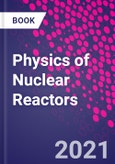Physics of Nuclear Reactors presents a comprehensive analysis of nuclear reactor physics. Editors P. Mohanakrishnan, Om Pal Singh, and Kannan Umasankari and a team of expert contributors combine their knowledge to guide the reader through a toolkit of methods for solving transport equations, understanding the physics of reactor design principles, and developing reactor safety strategies. The inclusion of experimental and operational reactor physics makes this a unique reference for those working and researching nuclear power and the fuel cycle in existing power generation sites and experimental facilities. The book also includes radiation physics, shielding techniques and an analysis of shield design, neutron monitoring and core operations.
Those involved in the development and operation of nuclear reactors and the fuel cycle will gain a thorough understanding of all elements of nuclear reactor physics, thus enabling them to apply the analysis and solution methods provided to their own work and research. This book looks to future reactors in development and analyzes their status and challenges before providing possible worked-through solutions.
Cover image: Kaiga Atomic Power Station Units 1 - 4, Karnataka, India. In 2018, Unit 1 of the Kaiga Station surpassed the world record of continuous operation, at 962 days. Image courtesy of DAE, India.
Please Note: This is an On Demand product, delivery may take up to 11 working days after payment has been received.
Table of Contents
1. Introduction2. Nuclear data
3. Types of nuclear reactors
4. Homogeneous reactor and neutron diffusion equation
5. Methods of solving neutron transport equation
6. Fuel burnup, fuel management and fuel cycle physics
7. Nuclear reactor kinetics
8. Nuclear reactor safety
9. Design methods and computer codes
10. Experimental and operational reactor physics
11. Radiation safety and radiation shielding design
12. Nuclear reactors of the future
Authors
P. Mohanakrishnan Formerly at Bhabha Atomic Research Centre, Mumbai, Maharashtra; Indira Gandhi Centre for Atomic Research, Kalpakkam, Tamil Nadu, India. Specialized in design and analysis of thermal and fast neutron reactors and reactor experiments.. Dr. Mohanakrishnan was a scientist at the Theoretical Physics Division of Bhabha Atomic Research Centre (BARC) for 13 years, and then at the Reactor Physics Division of Indira Gandhi Centre for Atomic Research (IGCAR) for 25 years. He was the Associate Director of the Reactor Physics Group at IGCAR, before becoming Adjunct Professor at, Manipal University, a position he held for 7 years. Presently, Dr. Mohanakrishnan is a consultant to the Atomic Energy Regulatory Board (AERB), Mumbai. He was recognized as a PhD guide by the University of Madras, Homi Bhabha National Institute (HBNI) and Manipal University. He was also the Dean of HBNI at IGCAR, specializing in reactor physics for the design, operation and safety of both thermal and fast reactors. He is experienced in the measurement of reactor parameters and has been involved in the development of computer codes for reactor analysis, preparation of manuals for reactor operation and guides for reactor safety. Om Pal Singh Formerly at Indira Gandhi Centre for Atomic Research, Kalpakkam, Tamil Nadu; Atomic Energy Regulatory Board, Mumbai, Maharashtra; Indian Institute of Technology Kanpur, Kanpur, Uttar Pradesh, India; Expertise: Nuclear Reactor Physics and Safety Design and Analysis.. Dr. Om Pal Singh has been a scientist at the Reactor Physics Division of Indira Gandhi Center for Atomic Research (IGCAR), Kalpakkam, Tamil Nadu, India for 31 years. At the time of transfer to Atomic Energy Regulatory Board (AERB), Mumbai, India, he was Head of the Reactor Physics Division in IGCAR. In AERB, he was secretary of the Board and Director of one of the Divisions for 6.5 years. Dr. Singh then became Visiting Professor at Indian Institute of Technology (IIT) Kanpur, Kanpur, UP, India for 5.5 years. He was recognized as a PhD guide by University of Madras and Bombay and co-guide at IIT-Kanpur and guided several PhD theses. He is specialized in theory and experimental work and is expert in reactor physics, deterministic safety analysis, Probabilistic Safety Analysis (PSA), Signal Processing Techniques and Regulatory Processes for nuclear and radiation facilities.He served as member of the 'Steering Committee of International Atomic Energy Agency (IAEA) on HRD in member states with nuclear power plants'. He served as 'IAEA Expert' several times in Indonesia during 1987 to 1991 and as Chief Investigator in several of the IAEA's Coordinated Research Programs including the one jointly from IAEA and European commission on core disruptive accident analysis of fast reactors. He is also holder of an Alexander Von Humboldt Foundation, German research fellowship. He served as Guest Editor (jointly with Dr. Srikumar Banerjee, Chancellor, HBNI, Mumbai, India) for a Special Issue: 'Development of Advanced Nuclear Technologies' in India published in the Elsevier journal: Progress in Nuclear Energy. K. Umasankari Head, Reactor Physics Design Division, Bhabha Atomic Research Centre, Mumbai, India and Senior Professor and PhD guide at Homi Bhabha National Institute, Mumbai, India. Dr. Umasankari is an experienced reactor physicist and currently the Head of the Reactor Physics Design Division at the Bhabha Atomic Research Centre (BARC). She is also a senior professor and PhD guide at the Homi Bhabha National Institute (HBNI). She is specialized in thorium utilization in reactors, nuclear data physics for thorium fuel cycle and fuel cycle studies for advanced systems. She has great experience in the design and safety of thermal neutron reactor systems, specifically pressurized heavy water reactors and its advanced versions, high temperature reactors and molten salt reactors. She also has significant contributions to coupled neutronic and thermal hydraulic safety studies, design of reactor physics experiments and development of computational tools for reactor design.








